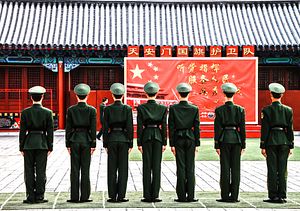After a string of deadly terror attacks, Chinese media outlets are full of news regarding the next steps in the war on terror with Chinese characteristics.
The centerpiece is a Jinghua Times piece on the recently announced year-long crackdown on terrorism, an effort that will be centered in Xinjiang. According to China Digital Times, China’s censors have demanded that articles on this topic be “prominently displayed” on the homepages of online news sites. The article summarizes a recent videoconference held by the Ministry of Public Security (MPS) on the topic of China’s ongoing crackdown on terrorism. According to MPS, since the beginning of May, China has broken up 23 gangs involved with terrorism or religious extremism, and has detained 200 suspects. Xinhua, in a separate article, highlighted one particular “lightning strike” in Hotan, Xinjiang. That raid, according to Xinhua captured five suspects and 1.8 tons of explosives, which had been purchased in Urumqi.
The Ministry promised to build on these results, seeking to root out terrorist groups before they plan strikes and to deter them through increased armed patrols and an increased security presence at crowded public areas. The MSP specified four types of people that will be targeted in its crackdown: those who use the internet to disseminate terrorist videos or materials calling for holy war; key figures involved in terrorism and religious extremism; those who have been charged multiple times with lighter crimes relating to public security or violence; and those who join terrorist or religious extremist groups beginning this year.
Other Chinese media also covered different angles of China’s crackdown on terrorism. China Daily published a story on the special training Chinese police officers are receiving so that they can begin carrying guns on their patrols. The article pointed out that first responders to the Kunming stabbing attack were unarmed and so unable to subdue the attackers. Global Times carried an article focusing on some of the details of the anti-terrorism crackdown. The article notes that the crackdown “will focus on terrorists and religious extremist groups, gun and explosive manufacturing dens and terrorist training camps.” The possession or trading of weapons (including guns and explosive materials) is banned, and possessing or distributing terrorist or extremist propaganda is outlawed.
Parsing the media coverage of China’s crackdown, it becomes clear that Beijing is unfolding a multi-pronged strategy. First, there’s an attempt to prevent the spread of terrorist ideology by cracking down on the spread of materials that encourage “holy war” or terrorist violence. At the same time, security forces will attempt to prevent terrorist attacks through tighter controls on the sale and possession of potential weapons and explosives, while also using intelligence methods to root out extremist and/or terrorist groups. Finally, China is seeking to increase the effectiveness of local police and other forces in deterring or (in a worst-case scenario) responding to terrorist attacks. This step involves increased training for security forces as well as arming police with firearms, traditionally reserved for China’s SWAT teams.

































